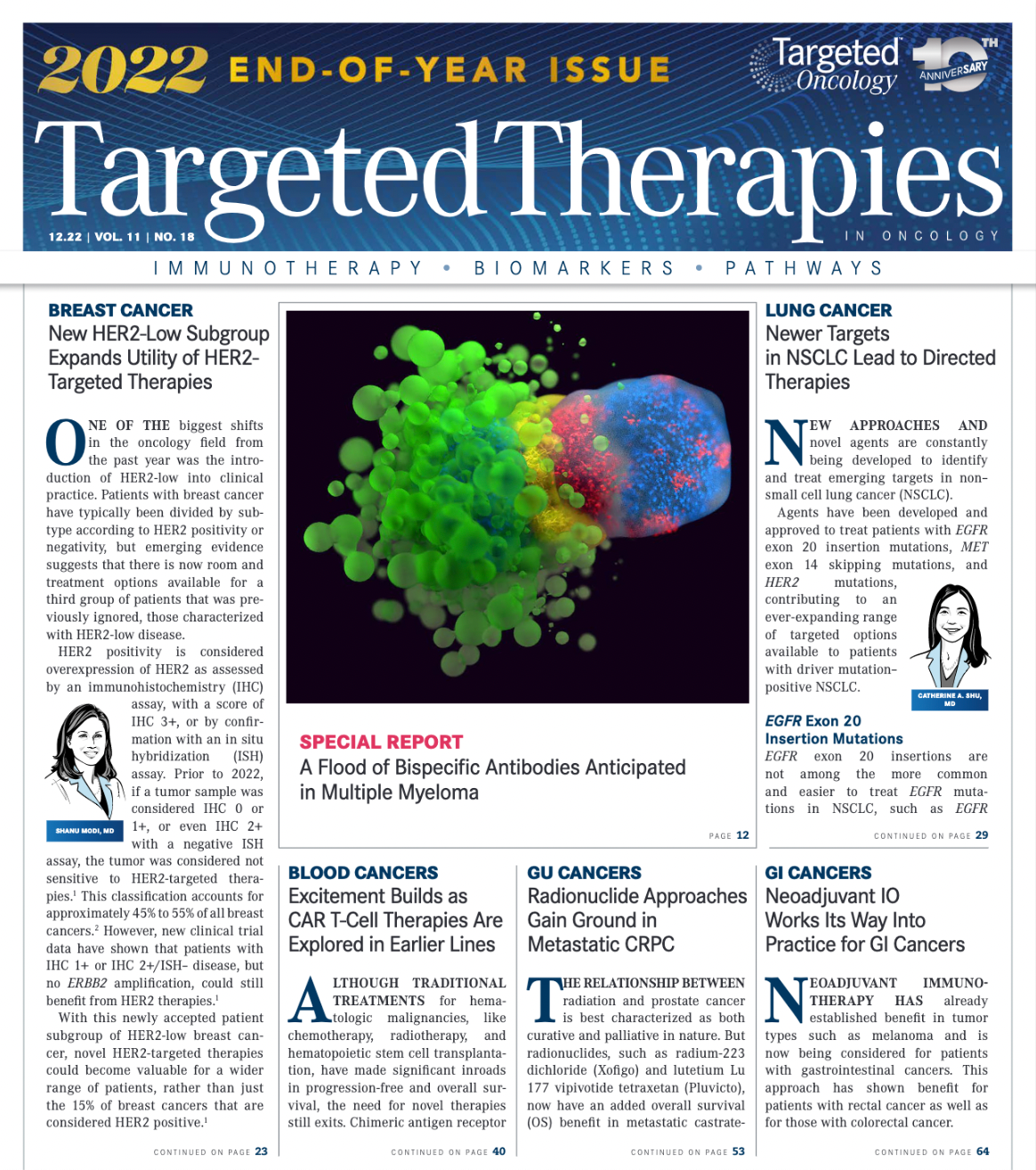Promising Role of ctDNA Is Explored in GI Malignancies
Circulating tumor DNA has improved risk stratification, increased minimal residual disease in patients with early-stage gastrointestinal cancers.

The use of circulating tumor (ct) DNA across gastrointestinal (GI) cancer settings has improved risk stratification, increased minimal residual disease in patients with early-stage disease, and led to a better understanding of tumor heterogeneity and genomic evolution, according to a presentation during the 40th Annual CFS® by Olatunji B. Alese, MD.1
“What is becoming evident is that liquid biopsy and other emerging ctDNA technologies are changing the paradigm in terms of how we treat or make cancer decisions,” Alese, an associate professor in the Department of Hematology and Medical Oncology at Emory University School of Medicine in Atlanta, Georgia, said during his presentation.
Colon Cancer
The role of adjuvant chemotherapy in stage II colon cancer remains debatable, but ctDNA may be able to identify which patients should be offered adjuvant chemotherapy vs close monitoring alone,2 according to Alese, who is also director of gastrointestinal oncology and associate medical director of the Ambulatory Infusion Center at Winship Cancer Institute of Emory University.
Tie et al2 assessed whether a ctDNA-guided approach could reduce the use of adjuvant chemotherapy without compromising recurrence risk. In the trial, patients with stage II colon cancer were randomly assigned to have treatment decisions guided by either ctDNA results or standard clinicopathologic features. For ctDNA-guided management, a ctDNA-positive result at 4 or 7 weeks after surgery led to the administration of oxaliplatin-based or fluoropyrimidine chemotherapy. Patients who were ctDNA negative were not treated.
The primary efficacy end point was recurrence-free survival (RFS) at 2 years. A key secondary end point was adjuvant chemotherapy use. After a median follow-up of 37 months, patients in the ctDNA-guided group received less adjuvant chemotherapy than the standard management group (15% vs 28%, respectively; relative risk, 1.82; 95% CI, 1.25-2.65). At the 2-year follow-up, RFS in the ctDNA-guided group was noninferior to that of the standard management group (93.5% vs 92.4%, respectively) ,and at 3 years, RFS in the treatment group who received adjuvant chemotherapy was 86.4% vs 92.5% in the control group who did not.2
“One other space in colorectal cancer where ctDNA has proven effective is in the metastatic setting,” Alese noted. CHRONOS (NCT03227926) was a phase 2 trial that explored blood-based identification of RAS/BRAF/EGFR mutation levels to tailor a chemotherapy-free anti-EGFR rechallenge
with panitumumab (Vectibix).1
Patients with RAS wild-type metastatic colorectal cancer underwent interventional ctDNA-based screening. Of 27 enrolled patients, 8 (30%) achieved partial response and 17 (63%) achieved disease control, including 2 unconfirmed responses.3
ctDNA Explored in Other GI Cancers
Gastroesophageal adenocarcinoma has a poor diagnosis and few therapeutic options. Investigators evaluated the role of ctDNA next-generation sequencing (ctDNA NGS) to guide treatment decision-making in 1630 patients with gastroesophageal adenocarcinoma.4 Investigators reported that known microsatellite instability–high tumors were robustly detected with ctDNA NGS. They noted that predictive biomarker assessment was optimized when tissue NGS and ctDNA NGS were combined in a complementary manner.4
In pancreatic cancer, KRAS and other mutations are prevalent in pancreatic cancers and can be detected using ctDNA, which has prognostic and predictive properties.5,6 “There is a strong correlation between ctDNA status and poor overall survival across the spectrum of pancreatic cancer presentation,” Alese said.
Hepatocellular carcinoma is another diagnosis in which the only curative intent treatments are either liver transplantation or resection. Unfortunately, approximately 60% of patients who undergo curative-intent hepatectomy will
recur within 5 years.7
In cholangiocarcinoma, tumor tissue and ctDNA samples were collected from 32 patients at baseline and during chemotherapy and underwent deep sequencing of 15 genes frequently mutated in cholangiocarcinoma.
A set of ctDNA samples was also submitted for 710 gene oncopanel sequencing to identify progression signatures.
Investigators observed significant correlation between baseline ctDNA variant allele frequency and progression-free survival in only the intrahepatic cholangiocarcinoma group (P= .0288).8
Further Reach
Alese also highlighted a study examining ctDNA and cell-specific horizontal gene transfer between human cancer cells.9 According to investigators, ctDNA can enter a host cell and integrates with the cell’s genome, transferring its genetic information. It was determined that retrotransposons of the ERVL, SINE, and LINE families are necessary for cell targeting and
the integration of ctDNA into host DNA.9
“This suggests that ctDNA can extend beyond just diagnostics [and] can promote cell-specific horizontal gene transfer,” Alese said. The use of ctDNA has significant potential in GI cancers. Its use in novel applications to determine pathogenesis, quantifying recurrence risk, and clinical trial design are undergoing exploration.
REFERENCES:
1. Alese OB. ctDNA: an emerging tool in GI cancers. Presented at: 40th Annual Chemotherapy Foundation Symposium Innovative Cancer Therapy for Tomorrow®; November 9-11, 2022; New York, NY. Accessed November 23, 2022. http://bit.ly/3TZjvb3
2. Tie J, Cohen JD, Lahouel K, et al; DYNAMIC Investigators. Circulating tumor DNA analysis guiding adjuvant therapy in stage II colon cancer. N Engl J Med. 2022;386(24):2261-2272. doi:10.1056/NEJ-Moa2200075
3. Sartore-Bianchi A, Pietrantonio F, Lonardi S, et al. Circulating tumor DNA to guide rechallenge with panitumumab in metastatic colorectal cancer: the phase 2 CHRONOS trial. Nat Med.2022;28(8):1612-1618. doi:10.1038/s41591-022-01886-0
4. Maron SB, Chase LM, Lomnicki S, et al. Circulating tumor DNA sequencing analysis of gastroesophageal adenocarcinoma. Clin Cancer Res. 2019;25(23):7098-7112. doi:10.1158/1078-0432.CCR-19-1704
5. Pietrasz D, Pécuchet N, Garlan F, et al. Plasma circulating tumor DNA in pancreatic cancer patients is a prognostic marker. Clin Cancer Res. 2017;23(1):116-123. doi:10.1158/1078-0432.CCR-16-0806
6. Del Re M, Vivaldi C, Rofi E, et al. Early changes in plasma DNA levels of mutant KRAS as a sensitive marker of response to chemotherapy in pancreatic cancer. Sci Rep. 2017;7(1):7931. doi:10.1038/s41598-017-08297-z
7. Bruix J, Sherman M; American Association for the Study of Liver Diseases. Management of hepatocellular carcinoma: an update. Hepatology. 2011;53(3):1020-1022. doi:10.1002/hep.24199
8. Ettrich TJ, Schwerdel D, Dolnik A, et al. Genotyping of circulating tumor DNA in cholangiocarcinoma reveals diagnostic and prognostic information. Sci Rep. 2019;9(1):13261. doi:10.1038/s41598-019-49860-0
9. Cinar M, Martinez-Medina L, Puvvula PK, et al. Retrotransposons facilitate the tissue-specific horizontal transfer of circulating tumor DNA between human cells.bioRxiv. Preprint posted online August 11, 2022. doi:10.1101/2022.08.10.501131
